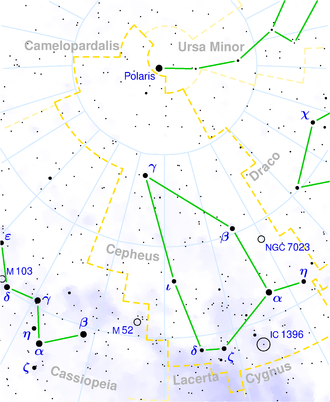Alderamin
| Stern Alderamin (α Cephei) | |||||||||||||||||||||||
|---|---|---|---|---|---|---|---|---|---|---|---|---|---|---|---|---|---|---|---|---|---|---|---|
| Alderamin im Sternbild Kepheus | |||||||||||||||||||||||
| AladinLite | |||||||||||||||||||||||
| Beobachtungsdaten Äquinoktium: J2000.0, Epoche: J2000.0 | |||||||||||||||||||||||
| Sternbild | Kepheus | ||||||||||||||||||||||
| Rektaszension | 21h 18m 34,77s [1] | ||||||||||||||||||||||
| Deklination | +62° 35′ 8,1″ [1] | ||||||||||||||||||||||
| Helligkeiten | |||||||||||||||||||||||
| Scheinbare Helligkeit | 2,45 mag [1] | ||||||||||||||||||||||
| Spektrum und Indices | |||||||||||||||||||||||
| B−V-Farbindex | +0,22 [2] | ||||||||||||||||||||||
| U−B-Farbindex | +0,11 [2] | ||||||||||||||||||||||
| R−I-Index | +0,11 [2] | ||||||||||||||||||||||
| Spektralklasse | A7 IV-V [1] | ||||||||||||||||||||||
| Astrometrie | |||||||||||||||||||||||
| Radialgeschwindigkeit | (−15,8 ± 1,1) km/s [3] | ||||||||||||||||||||||
| Parallaxe | (66,50 ± 0,11) mas [4] | ||||||||||||||||||||||
| Entfernung | (49,046 ± 0,081) Lj (15,038 ± 0,025) pc [4] | ||||||||||||||||||||||
| Visuelle Absolute Helligkeit Mvis | +1,56 mag [Anm 1] | ||||||||||||||||||||||
| Eigenbewegung [4] | |||||||||||||||||||||||
| Rek.-Anteil: | (150,55 ± 0,09) mas/a | ||||||||||||||||||||||
| Dekl.-Anteil: | (49,09 ± 0,09) mas/a | ||||||||||||||||||||||
| Physikalische Eigenschaften | |||||||||||||||||||||||
| Masse | 1,9 M☉ [5] | ||||||||||||||||||||||
| Radius | 2,5 R☉ [5] | ||||||||||||||||||||||
| Leuchtkraft | |||||||||||||||||||||||
| Effektive Temperatur | 7600 K [5] | ||||||||||||||||||||||
| Andere Bezeichnungen und Katalogeinträge | |||||||||||||||||||||||
| |||||||||||||||||||||||
| Anmerkung | |||||||||||||||||||||||
| |||||||||||||||||||||||
Alderamin (الذراع اليمين / aḏ-ḏirāʿ al-yamīn /‚der rechte Arm‘) ist der Eigenname des Sterns α Cephei (Alpha Cephei).
Alderamin hat eine scheinbare Helligkeit von 2,45 mag und gehört der Spektralklasse A7 an. Seine Oberfläche ist ca. 7600 Kelvin heiß. Er hat ca. die 18fache Leuchtkraft unserer Sonne, die 1,9fache Masse und etwa den 2,5fachen Durchmesser. Die Entfernung von Alderamin beträgt 49 Lichtjahre.
Siehe auch
Einzelnachweise
- ↑ a b c Hipparcos-Katalog (ESA 1997)
- ↑ a b c Bright Star Catalogue
- ↑ Pulkovo radial velocities for 35493 HIP stars
- ↑ a b c Hipparcos, the New Reduction (van Leeuwen, 2007)
- ↑ a b c d Alderamin. Jim Kaler, abgerufen am 29. Oktober 2018.
Auf dieser Seite verwendete Medien
Autor/Urheber: Copyright © 2003 Torsten Bronger., Lizenz: CC-BY-SA-3.0
It was created by Torsten Bronger using the program PP3 on 2003/08/18. At PP3's homepage, you also get the input scripts necessary for re-compiling the map.
The yellow dashed lines are constellation boundaries, the red dashed line is the ecliptic, and the shades of blue show Milky Way areas of different brightness. The map contains all Messier objects, except for colliding ones. The underlying database contains all stars brighter than 6.5. All coordinates refer to equinox 2000.0.
The map is calculated with the equidistant azimuthal projection (the zenith being in the center of the image). The north pole is to the top. The (horizontal) lines of equal declination are drawn for 0°, ±10°, ±20° etc. The lines of equal rectascension are drawn for all 24 hours. Towards the rim there is a very slight magnification (and distortion).

